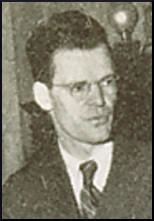Name Laurence Duggan | ||
 | ||
Education | ||
Laurence "Larry" Hayden Duggan (May 28, 1905 - December 20, 1948), was head of the South American desk at the United States Department of State during World War II. In 1948, Duggan fell to his death from the window of his office in New York, ten days after being questioned by the Federal Bureau of Investigation about whether he had had contacts with Soviet intelligence.
Contents
For many years he was widely thought to be an innocent and loyal public servant who was driven to suicide by unfounded accusations. In the 1990s, evidence from decrypted Soviet telegrams was revealed which indicated he had engaged in espionage for the Soviet Union.
Biography
Born in New York, Duggan studied at the Phillips Exeter Academy and Harvard University, before graduating in 1927. He worked for a number of years at the State Department—nine of those said years as head of the Latin American Division, and four of those as adviser on political relations. Starting in 1946, he was president of the Institute of International Education, which provided for a flow of exchange students between the United States and several other countries.
Duggan was recruited by actress Hede Massing as a Soviet spy in the mid-1930s. Duggan told the FBI that Henry Collins of the Ware group had also tried unsuccessfully to recruit him. Duggan was a close friend of Noel Field of the State Department. The GRU had also tried to recruit him through Frederick Field.
Peter Gutzeit, the Soviet Consulate in New York City, was also an officer in the NKVD. In 1934 he identified Laurence Duggan as a potential recruit. Boris Bazarov told Hede Massing that they wanted her to help recruit Duggan and Noel Field. The plan, suggested by Gutzeit, was to use Duggan to draw Field into the network. Gutzeit wrote on 3 October 1934, that Duggan "is interesting us because through him one will be able to find a way toward Noel Field... of the State Department's European Department with whom Duggan is friendly."
Massing later recalled: "Of the conquests I made while a Soviet agent, the one I regret most is Larry Duggan... Larry and Helen lived in the same house, on the floor below the Fields and were their most intimate friends.... Larry was, when I first heard of him, in the Latin American Division of the State Department... Larry impressed me as being an extremely tense, high-strung, intellectual young man."
Duggan provided Soviet intelligence with confidential diplomatic cables, including from American Ambassador William Bullitt. He was a source for the Soviets until he resigned from the State Department in 1944. He later served with the United Nations Relief and Rehabilitation Administration (UNRRA).
According to Boris Bazarov, Duggan told his Soviet handlers: "The only thing which kept him at his hateful job in the State Department where he did not get out of his tuxedo for two weeks, every night attending a reception, was the idea of being useful for our cause."
According to Whittaker Chambers in his 1952 memoirs:
What I particularly remember is Egmont Gaines sitting on one of the cots, chatting about the possibilities of underground organization and insisting that we must make contact with "Larry" Duggan, whom he called "very sympathetic." Thus, on my first day in Washington, I first heard the name of the late Laurence Duggan, who was then in the State Department, and later became chief of its Latin-American Division. Fourteen years later, during the Hiss Case, Duggan would be killed by a fall from his New York office window several days after he had been questioned by F.B.I. agents.
Personal and death
On December 15, 1948, Duggan fell to his death from his office at the Institute of International Education, located on the 16th floor of a building in midtown Manhattan. A few days later, the New York Police Department made public the result of its investigation, which concluded: "Mr. Duggan either accidentally fell or jumped."
He left a wife, Helen Boyd Duggan, and four children.
Deaths of W. Marvin Smith and others
On October 20, 1948, W. Marvin Smith, a U.S. Department of Justice attorney and notary with whom Alger Hiss had worked, was found dead in the southwest stairwell of the (then) seven-storey Justice building. Just after Laurence Duggan's death, the Associated Press reported:
The widow of W. Marvin Smith, justice department employee who died in a five storey plunge 2 months ago, expressed belief today that his death was simply an accident.
She told a reporter she feels certain it was not a suicide and was not connected in any way with his appearance as a minor witness in congressional hearings. Smith's death had been recalled in some newspaper accounts of the death of Laurence Duggan in New York City.
On Oct. 20, Smith hurtled to his death down circular stairwell in the justice department. That was also the opinion of justice officials.
Smith, 53, was an attorney in the solicitor general's office. Last summer, he figure in a minor way in the house committee on un-American activities.
In 1951, the Chicago Tribune newspaper speculated about "several suicides and mysterious deaths" among spies and government officials mostly related to the Hiss Case, including:
Venona
The Venona project succeeded in decrypting some Soviet intelligence cables that had been intercepted in the mid-1940s. The code name used for Laurence Duggan in the decrypted transcripts is "Frank" and "19". He is referenced in the following Venona decryptions, which provided information to the Soviets about Anglo-American plans for invading Italy during World War II:
